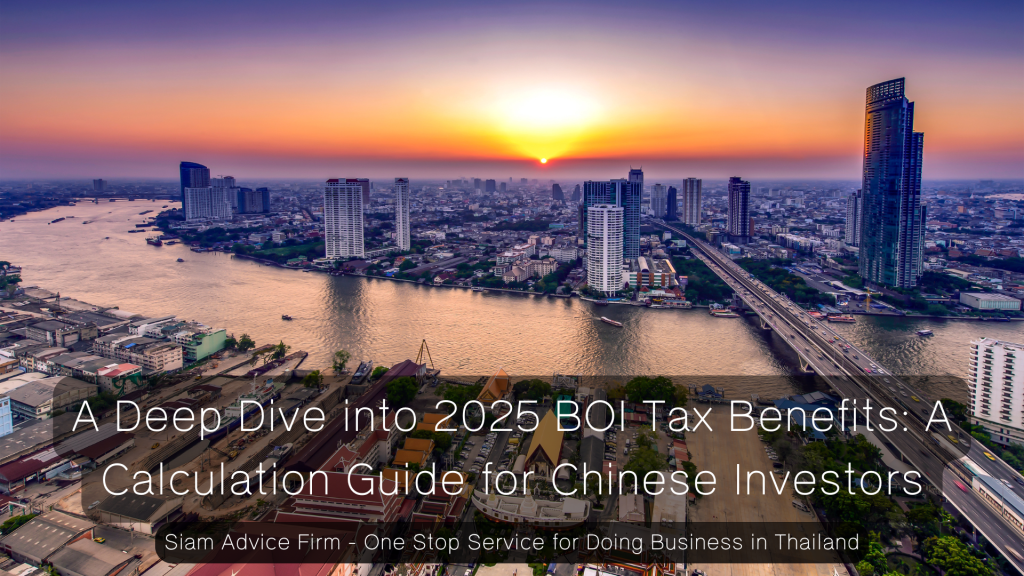
Imagine freeing up millions in capital—funds that would have otherwise been paid in taxes—over the next decade. Picture reinvesting that capital into faster growth, new technology, or aggressive market expansion. This isn’t just a hypothetical scenario; it’s the tangible financial power unlocked by a strategically planned promotion from the Thailand Board of Investment (BOI).
However, these lucrative tax benefits are not a one-size-fits-all package. They exist within a complex matrix of activity types, special conditions, and project locations. Many investors fail to maximize their potential savings simply because they don’t grasp the critical details of how these incentives work.
This guide will break down the most significant BOI tax benefits into clear, understandable components. Our goal is to demystify the rules and help you calculate the true financial power that a BOI promotion can bring to your investment project.
The Core Benefit: Corporate Income Tax Exemption (0% Tax)
The most powerful incentive offered by the BOI is the exemption from Corporate Income Tax (CIT). This means your company pays 0% tax on the net profit generated from the promoted activity for a specified period. Understanding two key factors is crucial to calculating this benefit.
- Key Factor #1 – The “Cap” (Exemption Limit): This is a critical detail many overlook. The total amount of tax you can save is often capped at 100% of your initial investment capital (excluding the cost of land and working capital). For example, if your investment in machinery and construction is 300 million baht, your total CIT exemption over the years cannot exceed 300 million baht. Certain high-priority activities may receive an uncapped exemption.
- Key Factor #2 – The Duration: The length of the tax holiday—typically 3, 5, 8, or up to 13 years—is determined by the “group” your business activity falls into. Higher-priority industries that involve advanced technology and innovation receive longer exemption periods.
Here is a simplified overview of the main activity groups:
| Group | Example Activities | Typical CIT Exemption Period |
| A1+ | Advanced Biotechnology, Nanotechnology, Advanced Materials | 10-13 Years (without cap) |
| A1 | Core Technologies, R&D | 8 Years (without cap) |
| A2 | High-Tech Industries (e.g., EV parts), Advanced Manufacturing | 8 Years |
| A3 | Less complex advanced technology activities | 5 Years |
| A4 | Other Supporting Industries | 3 Years |
Export to Sheets
Additional Benefit: 50% CIT Reduction for 5 Years
For certain projects, the benefits don’t end when the main tax holiday expires. After the 0% tax period, eligible companies can receive a 50% reduction in their Corporate Income Tax for an additional five years. This valuable extension is often linked to the location of your project, designed to encourage investment in specific strategic areas like the Eastern Economic Corridor (EEC) or other designated industrial estates. Projects in groups A1 or A2 that already receive an 8-year exemption may also be eligible for this 50% reduction for 5 years thereafter.
Reducing Upfront Costs: Import Duty Waivers
Beyond saving on profit tax, the BOI provides powerful tools to reduce your initial setup costs through the exemption of import duties.
- Waiver #1 – Machinery: This provides a complete exemption from import duties on machinery required for your project. For a manufacturing operation, this can translate into millions of baht in direct savings on your initial capital expenditure (Capex), significantly improving your project’s financial viability from day one.
- Waiver #2 – Raw Materials for Export Production: This is another crucial detail. You can receive an import duty exemption on raw and essential materials that are brought into Thailand specifically for the purpose of producing goods to be exported. This incentive is designed to make Thailand a competitive manufacturing hub for the global market.
Strategic Example: Calculation for a Chinese EV Parts Factory
Let’s make these benefits tangible with a realistic scenario.
Scenario:
- A Chinese company invests 500 million THB (excluding land and working capital) to build a factory producing advanced EV components in the EEC.
- The project is promoted in Group A2, granting an 8-year CIT exemption.
- The factory generates an average net profit of 100 million THB per year.
The Calculation:
- Standard Tax: Without BOI, the annual tax would be 100 million THB x 20% (standard CIT rate for profits over THB 3 million) = 20 million THB.
- Annual Savings with BOI: With the exemption, the company saves 20 million THB per year.
- Total Savings over 8 Years: 20 million THB/year x 8 years = 160 million THB.
This is on top of the millions saved from the upfront exemption on import duties for all the manufacturing machinery. The strategic planning of this BOI application has directly and significantly improved the project’s Return on Investment (ROI).
Conclusion
BOI tax benefits are not merely a “bonus”; they are a powerful financial instrument. When understood and utilized correctly, they can fundamentally change the financial trajectory of your investment, freeing up substantial capital for reinvestment and growth.
The key takeaway is this: maximizing these benefits is not an accident. It is the result of careful, strategic planning that happens before you submit your application.
Want to see how these benefits apply to your specific project? Read our Complete Guide to BOI Promotion for a full overview.
Is your project structured for maximum tax efficiency? Contact us for a strategic financial consultation.